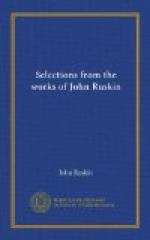“Put ye in the sickle, for the harvest is ripe."[135] The word is spoken in our ears continually to other reapers than the angels,—to the busy skeletons that never tire for stooping. When the measure of iniquity is full, and it seems that another day might bring repentance and redemption,—“Put ye in the sickle.” When the young life has been wasted all away, and the eyes are just opening upon the tracks of ruin, and faint resolution rising in the heart for nobler things,—“Put ye in the sickle.” When the roughest blows of fortune have been borne long and bravely, and the hand is just stretched to grasp its goal,—“Put ye in the sickle.” And when there are but a few in the midst of a nation, to save it, or to teach, or to cherish; and all its life is bound up in those few golden ears,—“Put ye in the sickle, pale reapers, and pour hemlock for your feast of harvest home.”
This was the sight which opened on the young eyes, this the watchword sounding within the heart of Turner in his youth.
So taught, and prepared for his life’s labour, sate the boy at last alone among his fair English hills; and began to paint, with cautious toil, the rocks, and fields, and trickling brooks, and soft white clouds of heaven.
[120] c. 1478-1511.
[121] Dante, alluding to Florence, Paradiso,
25. 5. “From the
fair sheepfold, where a lamb I slumbered.”
Longfellow’s tr.
[122] Allusions to pictures by Turner,
The Garden of the
Hesperides, and The Meuse: Orange-Merchantman
going to pieces on
the Bar.
[123] The pictures referred to are: The Death of Nelson, The Battle of Trafalgar, and The Fighting Temeraire being towed to its Last Berth (see cut). The first and third are in the National Gallery, London.
[124] Matthew xxiii, 14.
[125] Santa Maria della Salute, a church
conspicuously situated at
the junction of the Grand Canal and the
Giudecca.
[126] Liber Studiorum. “Interior of a church.” It is worthy of remark that Giorgione and Titian are always delighted to have an opportunity of drawing priests. The English Church may, perhaps, accept it as matter of congratulation that this is the only instance in which Turner drew a clergyman. [Ruskin.]
[127] 1785.
[128] Wolsey’s famous palace, twelve miles from London.
[129] I do not mean that this is his first acquaintance with the country, but the first impressive and touching one, after his mind was formed. The earliest sketches I found in the National Collection are at Clifton and Bristol; the next, at Oxford. [Ruskin.]
[130] The reference is to the two famous
ruined abbeys of
Yorkshire—Whitby and Bolton.
[131] The Tenth Plague of Egypt. [Ruskin.]
[132] Rizpah, the Daughter of Aiah. [Ruskin.]
[133] Duerer [1471-1528], German painter,
engraver, and designer.
Salvator [1615-73], Italian painter, etcher,
satirical poet, and
musical composer.




